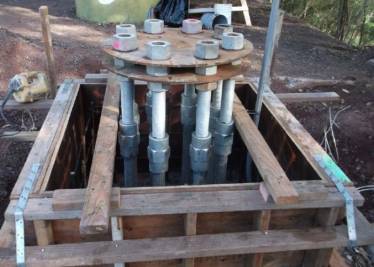What do I do if I poured my anchor bolts too low or too high?
The answer can be found in AISC Design Guide 1,Section 2.11.3:
“Anchor rod projections that are too short or too long must be investigated to determine if the correct anchor rods were installed. If the anchor rod is too short, the anchor rod may be projecting below the foundation. If the rod projection is too long, the embedment may not be adequate to develop the required tensile strength.”
Too Low

If your anchor bolts are poured too low, the AISC offers five options.
- Partially engage the nut
“Often, when the anchor rod is short, it may be possible to partially engage the nut. A conservative estimate of the resulting nut strength can be made based on the percentage of threads engaged, as long as at least half of the threads in the nut are engaged. Welding the nut to the anchor rod is not a prequalified welded joint and is not recommended.”
- Redrill and use an epoxy anchor
“If the anchor rod is too short and the rods are used only for column erection, then the most expedient solution may be to cut or drill another hole in the base plate and install a drilled-in epoxy-type anchor rod.”
- Extend using a coupling nut
“When the rods are designed for tension, the repair may require extending the anchor rod by using a coupling nut…”
- Butt weld extensions to the existing, already in place bolts if they are weldable anchors.
“When the rods are designed for tension, the repair may require extending the anchor rod by (using a coupling nut) or welding on a piece of threaded rod. ASTM F1554 Grade 36 anchor rods and ASTM F1554 Grade 55 with supplement S1 anchor rods can be extended by welding on a threaded rod. Butt welding two round rods together requires special detailing that uses a run out tab in order to make a proper groove weld. The run out tab can be trimmed off after welding, if necessary, and the rod can even be ground flush if required.”
- Extend the anchor by welding on splice bars to add on a threaded rod
“It is also possible to extend an anchor by using splice bars to connect a threaded rod extension.”
Too High
If your anchor bolts are poured too high, the AISC only has one recommendation: use plate washers to make up the difference.
“When anchor rods are too long, it is easy to add plate washers to attain an adequate thread length to run the nut down to the base plate. As noted previously, anchor rod details should always include an extra 3 in. or more of thread beyond what the detail dimension requires to compensate for some variation in anchor rod projection.”
More detailed information and diagrams can be found in section 2.11.3 of AISC Design Guide 1. Your project engineer should also be consulted before any of these repairs are undertaken to make sure the best method for the specific application is chosen.


We have installed light pole anchor bolts 2″ too high for a certain application, but still per manufacture’s instructed height. The amount of anchor in the base is acceptable, but we need to cut 2″ of the 3.5″ bolt projection. Should there be any concern with integrity or strength of the bolts? The best method to cut them? They are hot dip galvanized anchors. Thanks.
@Jordan- Those bolts can be cut in the field, but there are a couple things to watch out for. First, if the bolts are high strength, make sure they are cut without heat. Heat can alter the properties on high strength, heat treated items. Second is that you will need to recoat the cut end of the bolt. There are repair sprays, but we’d recommend checking with the project engineer to make sure they are happy with the repair method. Third is to be sure that the remaining bolt has enough thread so as to be usable. If you cut too much off, the nut may not properly engage.
If you have a weldable rod (gr 36) in place, why not just fillet weld the anchors to the baseplate?
@Rob- If the project engineer decides that welding is the most appropriate method of attaching the anchors to the baseplate, we see no reason why you couldn’t do that.
What is the proper procedure for a sheared off anchor bolt that is securing a metal frame pillar for a metal building? Is it common for anchor bolts to shear off ( we had three failures). My concern is that there was a bad batch of bolts from the manufacturer.
@Daniel- No, it is not common for the anchor bolts to shear off. There are several possibilities for why this is happening, but to be certain you might need to contact a failure analysis engineer.
My house is currently elevated. The anchor bolts are too short so the mason added threaded rod to extend their length. Most of the house has 3 pieces of 2 x 6 pressure treated wood for the sill plate. Only the sun porch needed 1 piece of pressure treated wood. The bolts were extended on most of the house. Is this ok? Also, do holes need to be drilled into the house itself to accommodate these bolts? I also see metal straps to bolt to the house along with universal service plates. Maybe that’s all I need.
@Patty- Anchor bolts are commonly extended in the manner you are describing. As for whether or not this is the appropriate fix in your situation, I cannot say. You would need to consult an engineer.